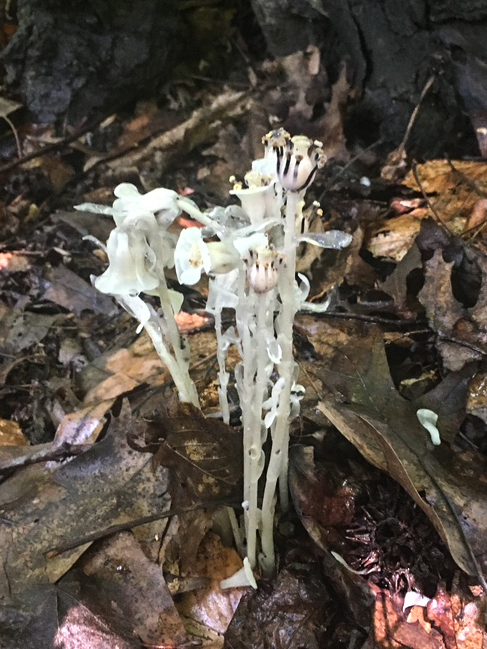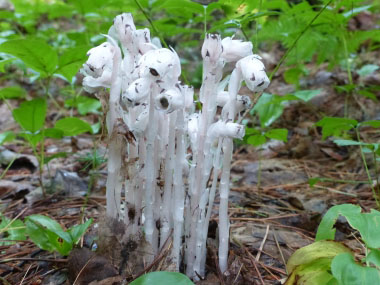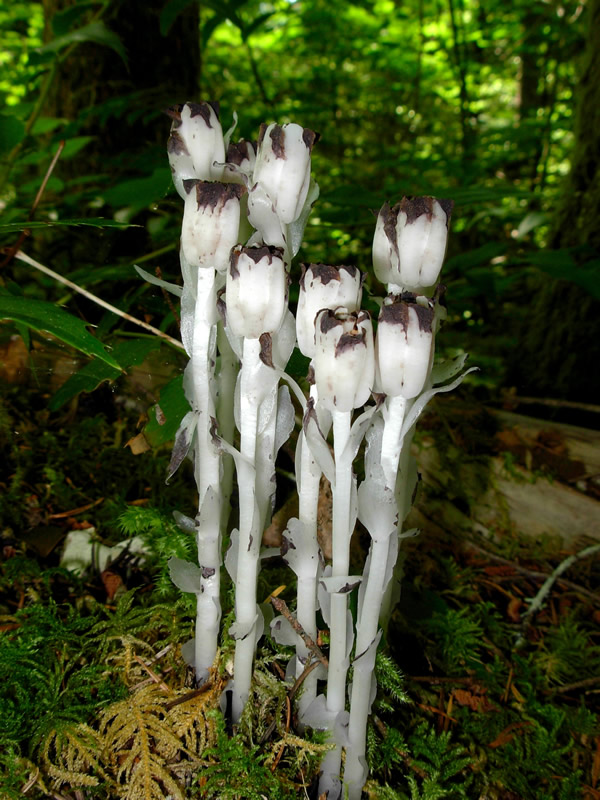14+ Indian Pipes Plant
What is the plant. Indian pipe is often found in near beech trees too which also prefer damp cool soil.
Indian Pipe Monotropa Uniflora Species Page
Web This unusual plant is a saprophyte and has no chlorophyll.

. Members of this family were formerly considered part of the family Ericaceae but recent evidence suggests they should be considered separate. The leaves are represented only by. Web This relationship is called mycotropism.
Others are just intriguing. Web Indian Pipe lacks chlorophyll accounting for its translucent white color. A plant without chlorophyll known as Indian pipes.
The plant arises from a tangled mass of rootlets grows 1525 cm 610 inches tall and lacking chlorophyll is white pinkish or rarely red. Like a fungus its root system soaks up necessary nutrients from surrounding decaying plant matter. However Indian Pipe is not a commonly encountered wildflower.
1 2 The plant is waxy white but some specimens have been described as having black flecks or pale pink coloration. Web The Indian pipe is one of many plants with no chlorophyll that tap into mycorrhizae to sponge off of living plants and are called myco-heterotrophs. These mycorrhizal fungi help the plants take up water and nutrients that might otherwise be inaccessible to the plants.
The plant itself is unusual emerging like ghostly white fingers from the leaf litter beneath certain birch and evergreen tree. Web Many of the common names for this unusual plant are shiver-inducing. The Forests Pain Reliever That Are Risky But Effective By Rob Nelson The ghost pipe also known as the indian pipe is white to almost translucent.
Indian Pipes translucent leaves are overlapping and scale-like. To -344 C -30 F. They cannot make it themselves.
Ghost Plant Corpse Plant Death Plant Convulsion Root. Because it has no chlorophyll and doesnt depend on photosynthesis this ghostly white. Web Description Indian pipe is a perennial wildflower that lacks chlorophyll and is therefore white sometimes pinkish.
Seeds are like powder and disperse by wind. This parasitic plant maximizes a soil fungus mycorrhizae to access food from neighboring trees. Indian Pipe or Indian Pipestem Fairy Smoke and Eyebright.
Web Storm surge is a major danger in Florida. It is absent from the southwest intermountain west and the central Rocky mountains. We see it as it pops out of the forest as if it plant had a baby with a mushroom.
Web Indian pipe is found in dark shady woods with rich moist soil and plenty of decaying leaves and other plant matter. Because it can not synthesize its own energy this plant is a saprophyte. Web Indian Pipes Ghost Pipes.
Like most saprophytic plants Indian pipe truns dark brown to black when it is starved or in fruit. Web Indian pipe is a unique perennial plant without chlorophyll. Web Monotropa uniflora also known as ghost plant ghost pipe or Indian pipe is an herbaceous perennial plant native to temperate regions of Asia North America and northern South America but with large gaps between areas.
Without chlorophyll indian pipe is one of around 3000 species of non-photosynthetic flowering plants worldwide. Its clearly a flower stalk yet is easily mistaken by the casual passerby as a mushroom. What is Indian Pipe used for you may ask.
Often mistaken for a fungus Monotropa uniflora is sometimes called the ghost plant in honor of its near-total lack of pigmentation. Web Indian pipe is a perennial wildflower with a wide geographic distribution throughout the United States from Maine to California and from Florida to Alaska. The ovary develops into a woody capsule with slits through which the tiny seeds pass.
Therefore this chlorophyll-lacking plant ultimately derives its energy from trees who use chlorophyll to photosynthesize. Do not let dry out between waterings Sun Exposure. It obtains its nutrients by tapping into the resources of trees indirectly through mycorrhizal fungi.
If it dries out it turns black. Parasites that feed on other parasites. Web Plants such a Indian Pipe are called epiparasites.
Web Indian Pipe. A stroll through a Michigan woodland may reveal an oddity of the plant world. Habitat This plant occurs in rich habitats dense moist forests usually with a lot of surface leaf litter often in a situation that is too shaded for autotrophic photosynthetic growth.
Perennials Parasites and Hemiparasites Water Requirements. The stem is topped by a single nodding white pipe-bowl-shaped or bell-shaped flower which turns black when bruised. Web Indian Pipe also known as Ghost Plant is a unique and fascinating plant that has captured the imagination of people around the world.
Web It is usually found in moist shady areas. Web Indian pipes are a plant lacking chlorophyll that hitchhike with native Michigan trees like oaks. This fascinating plant Monotropa uniflora is definitely one of natures weird wonders.
In this case it has a relationship with specific fungi that are mycorrhizal on trees. Instead they are mycoheterotrophic meaning they obtain nutrients by parasitizing a type of fungi that associate with plant roots. Web Ghost pipe also known as Indianpipe is a member of the Monotropaceae family.
It is commonly found near dead stumps. Web The filtering process will remove strontium-90 and iodine-129 and the concentration of carbon-14 in the contaminated water is far lower than its regulatory standard for discharge according to. Web Indian pipes require moist thick leaf cover typically found in mature forests.
The myco part means fungus since they are using the fungus to procure their food. It usually grows in small clusters. Plants like Indian Pipe are known as epiparasites.
Without the need for sunlight the only reason Indian pipes poke their heads above the soil is to be pollinated by long-tongued bees. It is sometimes misidentified as a mushroom. Little is known about the pollination of Indian Pipe but bees and skipper butterflies have been observed to visit them.
Identification of Indian Pipe Wildflowers of the Adirondacks. Partial to Full Shade Foliage. A mass of dark brittle saprophytic roots produces the ivory-white waxy stem growing 4-10 inches high and covered with scaly bracts.
Heterotroph means they have to go get food. Web Indian-pipe Monotropa Uniflora. Monday July 8 2013.
A storm surge warning is in effect for Englewood to Indian Pass including Tampa BayThis means there is a danger of life-threatening inundation from. Web 10 to 20 cm 4 to 8. Indian Pipe on the Boreal Life Trail 21 June 2014.
Web Indian-pipe is a mycotroph which means that it parasitizes fungi. The plant grows in most temperate regions of the United States and is also found in northern parts of. The flowers arise singly on a white scaly stem and are urn-shaped nodding with 4 or 5 petals and no sepals.
While it may not be edible Indian Pipe has a rich history of medicinal and spiritual uses that make it an important part of many cultures. Web Indian pipes are unusual in that they do not photosynthesize. Most of the year this plant is unseen living underground and only appearing to bloom for a couple months in the summer.
Although many heterotrophic plants. The Indian Pipe grows throughout Canada most of the US some European countries eastern Asia and possibly parts of South America. Because they do not need any sunlight to live they can live in very dark sites such as the floor of deep forests.
Requires consistently moist soil.

Indian Pipes The Parasitic Plants In Bloom At The New York Botanical Garden Science Talk Archive

Ghost Pipe Aka Indian Pipe Wildflower Is Rare Mystical And Appears Above Ground Just One Week Each Year Wandering Rose Travels

File Pink Indian Pipes Jpg Wikipedia

Indian Pipe Pictures Flowers Leaves Identification Monotropa Uniflora
More Sightings And Stories About Indian Pipe Plant But Still Looking For Information Oregonlive Com

Docaitta Lifestyle Indian Pipe An Exotic And Unusual Plant

Indian Pipe Description Nutrition Britannica
Indian Pipe Medicinal Herb Info

Indian Pipe Monotropa Uniflora Youtube

Monotropa Uniflora

Monotropa Uniflora Wikipedia

Indian Pipe Great Lakes Sacred Essences

Indian Pipe Monotropa Uniflora

Indian Pipe Country Roads Magazine

Monotropa Uniflora Wikipedia
Monotropa Uniflora Indian Pipe Minnesota Wildflowers

Monotropa Uniflora Indian Pipe Wildflowers Of The Pacific Northwest